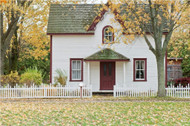What to Check First When Moving into an Older Home
Nov 12th 2024
The historic charm, vintage architecture, and mature landscaping are only some of the perks of moving into an older home. However, these properties can present unique challenges and hidden issues that simply aren’t present in newer houses. Before you go on and get too comfortable, it’s always worth checking out a few important areas to ensure that your new (old) house is safe, efficient, and ready for you to settle in comfortably.
To that end, we’ve compiled this guide to the key things to look over when moving into an older home:
Start with the Structure: Foundation and Roof
One of the first areas to inspect in an older home is its structural integrity, which includes the foundation and the roof.
Over time, the foundation of an older home can shift and settle, which can lead to cracks and uneven floors. In that same vein, the roof may have experienced years of exposure to weather, which can cause wear and leaks.
Checking the Foundation
The foundation is what holds your entire home up, which is why it’s essential to make sure that it’s in good shape. To check it, walk around the exterior of the house and keep an eye out for visible cracks in the foundation walls – especially ones that seem wider than an eighth of an inch (⅛).
At the same time, pay attention to the floors and walls inside the house for signs of a shifting foundation, too. These can include sloping floors, doors that don’t close properly, or gaps in windows and door frames.
Checking the Condition of the Roof
The roof, on the other hand, is what protects your home from the elements – and it’s essential for it to be sturdy. In many older homes, the roofing materials may have deteriorated over time, which can lead to leaks or even structural issues or damage.
Missing, broken, or curled shingles are telltale indicators of wear. You might also want to check the attic for signs of leaks, which include water stains or soft spots. If you notice any issues, it may be worth hiring a professional to inspect the roof further and determine if repairs or a replacement are needed.
Safety First: Plumbing and Electrical Systems
Many older homes have outdated plumbing and electrical systems that may not be up to modern safety standards. This can be a major safety concern, especially if the wiring or pipes haven’t been updated in decades.
Plumbing Pipes and Fixtures
Old plumbing can lead to leaks, water damage, and even health hazards, especially if the pipes contain lead.
Places to check include underneath sinks and in utility rooms: look for any visible corrosion or leaks in the pipes. It’s also a good idea to turn on the taps and flush the toilets to see if the water pressure is adequate. Slow drainage or low water pressure could mean there’s a clog, or worse, an issue with the pipes themselves. If you’re concerned about lead pipes, you may want to have your water tested.
Electrical Wiring and Outlets
Older homes often have outdated wiring systems that were not designed to handle today’s modern electrical demands. Noticeable issues such as flickering lights, warm outlets, or old-fashioned knob-and-tube wiring are all signs that it may be time for an upgrade. This is particularly important if the home still has a fuse box rather than a circuit breaker panel. Check all outlets to make sure they work, and consider hiring an electrician to inspect the wiring and ensure it’s safe and efficient.
Inspect for Mold and Mildew
One of the most common (and hidden) issues in older homes is mold. It thrives in dark and damp spaces, and can pose serious health risks – especially for those with respiratory issues or allergies. Mold can be hard to detect with the naked eye, but using a home mold test kit can be a practical solution.
How to Use Micro Balance Health Products’ Home Mold Test Kit
Micro Balance Health Products’ home mold test kit, the EC3 Mold Screening Test Kit, includes everything you need to test for elevated mold levels in your indoor air or belongings. Each kit contains 6 mold test plates, as well as detailed instructions on how to perform the test.
To start, choose a few areas that are more prone to moisture, like basements, bathrooms, or attics. Take one of the test plates out of the clear plastic sleeve that it comes in, then take its lid off. Place the open plate on a flat surface, away from walls and windows. After an hour, place the lid back on the test plate and seal it closed with tape. Wrap the sealed plate in aluminum foil and place it in a plastic bag out of direct sunlight. After 5 days, use the package insert to read your results.
By knowing what to check first in your new (old) home, you can make sure that it’s safe and comfortable for you and your family. A little bit of proactive inspection and maintenance will go a long way in helping you enjoy it for years to come!



